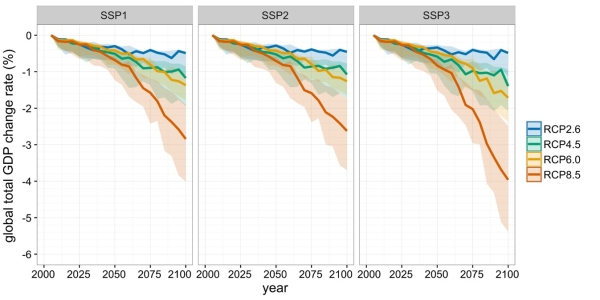Information of Paper
Autohrs: Jun’ya Takakura, Shinichiro Fujimori, Kiyoshi Takahashi, Yasuaki Hijioka, Tomoko Hasegawa, Yasushi Honda, and Toshihiko Masui
Year:2017
Journal:Environmental Research Letters, 12(6) 064010 2017
Link to the paper
Abstract
Worker’s exposure to hot environments is expected to increase as a result of climate change. In order to prevent heat-related illness, it is recommended that workers take breaks during working hours. However, this would lead to reductions in worktime and labor productivity. In this study, we estimate the economic cost of heat-related illness prevention through worker breaks associated with climate change under a wide range of climatic and socioeconomic conditions. We calculate the worktime reduction based on the recommendation of work/rest ratio and the estimated future wet bulb glove temperature, which is an index of heat stresses. Corresponding GDP losses (cost of heat-related illness prevention through worker breaks) are estimated using a computable general equilibrium model throughout this century. Under the highest emission scenario, GDP losses in 2100 will range from 2.6 to 4.0% compared to the current climate conditions. On the other hand, GDP losses will be less than 0.5% if the 2.0ºC goal is achieved. The benefit of climate-change mitigation for avoiding worktime loss is comparable to the cost of mitigation (cost of the greenhouse gas emission reduction) under the 2.0ºC goal. The relationship between the cost of heat-related illness prevention through worker breaks and global average temperature rise is approximately linear, and the difference in economic loss between the 1.5ºC goal and the 2.0ºC goal is expected to be approximately 0.3% of global GDP in 2100. Although climate mitigation and socioeconomic development can limit the vulnerable regions and sectors, particularly in developing countries, outdoor work is still expected to be affected. Effectiveness of some adaptation measures such as additional installation of air conditioning devices or shifting the time of day for working are also suggested. In order to reduce the economic impacts, adaptation measures should also be implemented as well as pursing ambitious climate-change mitigation targets.
Click the figures to widen the view

Rapid, normal, and stalled socioeconomic development are assumed for SSP1, SSP2, and SSP3. Assumption on climatic conditions are represented by RCP. RCP2.6 corresponds to the 2-degree goal. Shaded areas and lines correspond to median and range of 5 different climate models.




